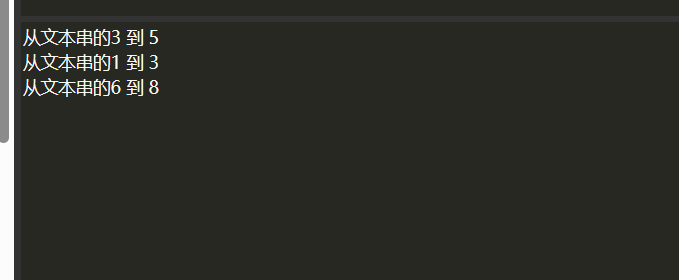字符串匹配算法
字符串匹配算法是指在一个文本串(较长的字符串)中查找一个模式串(较短的字符串)的出现位置或匹配情况的算法。以下是几种常见的字符串匹配算法
1.朴素字符串匹配算法(Brute-Force算法):
从文本串的首字母开始依次与模式串作比较,直到找到匹配或者比较到文本串末尾。时间复杂度为O(nm),其中n为文本串长度,m为模式串长度。
示例代码:
#include <iostream>#include <string>using namespace std;// 定义匹配结果结构体struct MatchResult {bool found; // 是否找到匹配int startIndex; // 匹配起始索引int endIndex; // 匹配结束索引};// 优化后的朴素字符串匹配算法函数MatchResult bruteForceSearch(const string& text, const string& pattern) {int n = text.length(); // 文本串的长度int m = pattern.length(); // 模式串的长度int startIndex = -1; // 匹配起始索引int endIndex = -1; // 匹配结束索引// 在文本串中滑动窗口for (int i = 0; i <= n - m; i++) {int j;// 逐个字符比较for (j = 0; j < m; j++) {if (text[i + j] != pattern[j])break;}// 找到完全匹配if (j == m) {startIndex = i; // 设置匹配起始索引endIndex = i + m - 1; // 设置匹配结束索引break;}}// 构造匹配结果结构体MatchResult result;if (startIndex != -1) {result.found = true;result.startIndex = startIndex;result.endIndex = endIndex;} else {result.found = false;result.startIndex = -1;result.endIndex = -1;}return result;}int main() {string text = "ABCABDABEABF"; // 文本串string pattern = "ABD"; // 模式串MatchResult result = bruteForceSearch(text, pattern); // 调用优化后的朴素字符串匹配算法函数// 根据匹配结果进行输出if (result.found) {cout << "从文本串的 " << result.startIndex << " 到 " << result.endIndex << endl;} else {cout << "未找到匹配的字符串" << endl;}return 0;}
代码解析:
- 定义了一个名为 MatchResult 的结构体,用于存储匹配结果的相关信息。结构体包含三个成员变量:found 表示是否找到匹配,startIndex 表示匹配的起始索引,endIndex 表示匹配的结束索引。
- 定义了一个名为 bruteForceSearch 的函数,用于执行优化后的朴素字符串匹配算法。函数的输入参数为文本串 text 和模式串 pattern,返回一个 MatchResult 结构体,表示匹配结果。
- 在函数内部,我们首先获取文本串和模式串的长度,初始化匹配的起始索引 startIndex 和结束索引 endIndex 为 -1。
- 然后,我们使用两层循环:外层循环控制滑动窗口的起始位置,内层循环逐个字符比较文本串和模式串的对应字符。
- 如果在内层循环中找到了完全匹配,即内层循环正常结束(j == m),我们设置匹配的起始索引为当前滑动窗口的起始位置 i,结束索引为起始索引加上模式串的长度减1。
- 当找到完全匹配后,我们跳出外层循环(使用 break 语句)。
- 接下来,我们根据匹配的起始索引是否为 -1 分别设置 MatchResult 结构体的 found 字段为 true 或 false,并将匹配的索引值赋值给 startIndex 和 endIndex。
- 最后,我们返回构造好的 MatchResult 结构体给调用者。
- 在 main 函数中,我们定义了一个文本串 text 和一个模式串 pattern。
- 然后,我们调用优化后的朴素字符串匹配算法函数 bruteForceSearch 并将其返回的结果存储在 result 中。
- 最后,我们根据匹配结果的 found 字段进行判断输出。如果 found 为 true,表示找到了匹配,我们输出匹配的起始索引 startIndex 和结束索引 endIndex。如果 found 为 false,表示未找到匹配,我们输出相应的提示信息。
这样,以上代码实现了一个简单的朴素字符串匹配算法,并通过 MatchResult 结构体将匹配的结果返回给主函数以进行进一步处理和输出。运行结果

2.KMP算法:
KMP算法利用模式串的特性,通过建立一个部分匹配表(Partial Match Table)来避免在模式串和文本串中的不必要的匹配和回溯。它的时间复杂度为O(n+m),其中n为文本串长度,m为模式串长度。
示例代码:
#include <iostream>#include <string>#include <vector>using namespace std;vector<int> getFailureFunction(const string& pattern) {int m = pattern.length(); // 模式串的长度vector<int> failure(m, 0); // 部分匹配表int j = 0;for (int i = 1; i < m; i++) {if (pattern[i] == pattern[j]) {failure[i] = j + 1;j++;} else {if (j != 0) {j = failure[j - 1];i--;} else {failure[i] = 0;}}}return failure;}vector<int> kmpSearch(const string& text, const vector<string>& patterns) {int n = text.length(); // 文本串的长度vector<int> positions; // 存储匹配的位置信息for (const string& pattern : patterns) {int m = pattern.length(); // 模式串的长度vector<int> failure = getFailureFunction(pattern); // 构建部分匹配表int i = 0, j = 0;while (i < n) {if (text[i] == pattern[j]) {if (j == m - 1) { // 完全匹配positions.push_back(i - j); // 存储匹配的起始索引break;} else {i++;j++;}} else {if (j != 0) { // 部分匹配,根据部分匹配表来移动模式串j = failure[j - 1];} else {i++;}}}}return positions;}int main() {string text = "ABCABDABEABF"; // 文本串vector<string> patterns = {"ABD", "BCA", "ABE"}; // 多个模式串vector<int> positions = kmpSearch(text, patterns); //if (positions.empty()) {cout << "未找到匹配的字符串" << endl; // 未找到匹配} else {for (int i : positions) {cout << "从文本串的" << i << " 到 " << i + patterns[0].length() - 1 << endl;// 打印匹配的起始索引和结束索引(这里假设所有模式串的长度相同)}}return 0;}
代码解析:
- getFailureFunction 函数实现了构建模式串的部分匹配表。该表存储了每个位置字符前缀和后缀相等的最长部分匹配长度。使用双指针 i 和 j 遍历模式串,根据当前字符是否匹配进行更新。
- kmpSearch 函数实现了多个模式串的搜索。对于每个模式串,首先获取其长度 m,然后构建部分匹配表。使用双指针 i 和 j 在文本串中进行匹配的遍历。如果当前字符匹配,继续向后匹配,直到完全匹配。如果不匹配,根据部分匹配表移动模式串的指针。一旦找到完全匹配,将匹配的起始索引保存到 positions 中。
-
在 main 函数中,定义了文本串 text 和多个模式串的向量 patterns,分别表示要搜索的文本和模式串。调用 kmpSearch 函数获取匹配的位置信息,并将结果保存到 positions 中。
运行结果

小拓展:
for (int i : positions) {cout << "从文本串的" << i << " 到 " << i + patterns[0].length() - 1 << endl;
上面的代码是C++11中的foreach循环。
其基本的结构为for (element : container) {// 循环体,对每个 element 进行操作}
其中,container 是一个可迭代的容器(如 vector、list、array 等),element 是容器中的每个元素。
在循环的每次迭代中,element 会依次被赋值为容器中的每个元素,并执行循环体内的操作。下面是简单的例子:
vector<int> numbers = {1, 2, 3, 4, 5};for (int num : numbers) {cout << num << " ";//输出结果为1 2 3 4 5}
3.Rabin-Karp算法:
Rabin-Karp算法通过哈希函数对模式串和文本串中的子串分别进行哈希,然后比较哈希值来判断是否匹配。它的时间复杂度为O(n+m),但在最坏情况下可能达到O(nm),其中n为文本串长度,m为模式串长度。
示例代码:
#include <iostream>#include <string>#include <vector>using namespace std;const int prime = 101; // 用于计算哈希值的质数vector<pair<int, int>> rabinKarpSearch(const string& text, const string& pattern) {int n = text.length(); // 文本串的长度int m = pattern.length(); // 模式串的长度vector<pair<int, int>> positions; // 存储匹配位置信息int patternHash = 0; // 模式串的哈希值int windowHash = 0; // 窗口的哈希值int power = 1; // 用于计算哈希值的幂次// 计算模式串的哈希值和初始窗口的哈希值for (int i = 0; i < m; i++) {patternHash = (patternHash * prime + pattern[i]) % prime;windowHash = (windowHash * prime + text[i]) % prime;if (i != 0) {power = (power * prime) % prime; // 计算 prime^(m-1)}}// 在文本串中滑动窗口并比较哈希值for (int i = 0; i <= n - m; i++) {// 如果哈希值匹配并且窗口内的字符串与模式串相同,则找到匹配if (patternHash == windowHash && text.substr(i, m) == pattern) {positions.push_back(make_pair(i, i + m - 1));}// 滚动更新窗口哈希值if (i < n - m) {windowHash = (prime * (windowHash - text[i] * power) + text[i + m]) % prime;if (windowHash < 0) {windowHash += prime; // 处理负数情况}}}return positions;}int main() {string text = "ABCABDABEABF"; // 文本串string pattern = "ABD"; // 模式串vector<pair<int, int>> positions = rabinKarpSearch(text, pattern);if (positions.empty()) {cout << "未找到匹配的字符串" << endl; // 未找到匹配} else {for (auto pos : positions) {cout << "文本串的 " << pos.first << "到 " << pos.second << endl;}}return 0;}
代码解析:
在rabinKarpSearch函数中,首先计算模式串的哈希值和初始窗口的哈希值。然后,在文本串中滑动窗口,比较窗口的哈希值与模式串的哈希值是否相等,以及窗口内的字符串与模式串是否相等。如果相等,则将匹配的起始索引和结束索引存储到positions向量中。
在main函数中,定义了一个文本串text和一个模式串pattern。然后调用rabinKarpSearch函数进行搜索,并将返回的匹配位置存储到positions向量中。如果没有找到匹配的字符串,输出提示信息”未找到匹配的字符串”。如果找到匹配的字符串,遍历positions向量并输出每一个匹配的起始索引和结束索引。
运行结果同上(想偷懒)
4.Aho-Corasick算法:
Aho-Corasick算法是一种多模式匹配算法,用于在一个文本串中同时匹配多个模式串。它利用自动机的思想构建一个Trie树,并通过状态转移和失配函数来处理匹配过程。它的时间复杂度为O(n+m+k),其中n为文本串长度,m为模式串平均长度,k为模式串数量。
示例代码:(写的很烂)
#include <iostream>#include <string>#include <vector>#include <algorithm>using namespace std;struct TrieNode {vector<TrieNode*> children;vector<int> patterns;TrieNode* fail;TrieNode* parent;char ch;TrieNode(TrieNode* parent, char ch) {children.resize(26, nullptr);this->fail = nullptr;this->parent = parent;this->ch = ch;}};class AhoCorasick {public:AhoCorasick(const vector<string>& patterns) {root = new TrieNode(nullptr, '\0');this->patterns = patterns;buildTrie(this->patterns);buildFailPointers();}vector<pair<int, int>> search(const string& text) {vector<pair<int, int>> positions;TrieNode* currNode = root;for (int i = 0; i < text.length(); i++) {char ch = text[i];while (currNode != root && currNode->children[ch - 'a'] == nullptr) {currNode = currNode->fail;}if (currNode->children[ch - 'a'] != nullptr) {currNode = currNode->children[ch - 'a'];}TrieNode* tempNode = currNode;while (tempNode != root) {for (int patternIndex : tempNode->patterns) {int startPos = i - this->patterns[patternIndex].length() + 1;int endPos = i;positions.push_back(make_pair(startPos, endPos));}tempNode = tempNode->fail;}}return positions;}private:TrieNode* root;vector<string> patterns;void buildTrie(const vector<string>& patterns) {for (int i = 0; i < patterns.size(); i++) {insertPattern(patterns[i], i);}}void insertPattern(const string& pattern, int patternIndex) {TrieNode* currNode = root;for (char ch : pattern) {if (currNode->children[ch - 'a'] == nullptr) {TrieNode* newNode = new TrieNode(currNode, ch);currNode->children[ch - 'a'] = newNode;}currNode = currNode->children[ch - 'a'];}currNode->patterns.push_back(patternIndex);}void buildFailPointers() {root->fail = root;vector<TrieNode*> nodeQueue;for (int i = 0; i < 26; i++) {if (root->children[i] != nullptr) {root->children[i]->fail = root;nodeQueue.push_back(root->children[i]);}}while (!nodeQueue.empty()) {TrieNode* currNode = nodeQueue.back();nodeQueue.pop_back();for (int i = 0; i < 26; i++) {if (currNode->children[i] != nullptr) {TrieNode* childNode = currNode->children[i];nodeQueue.push_back(childNode);TrieNode* failNode = currNode->fail;while (failNode != root && failNode->children[i] == nullptr) {failNode = failNode->fail;}if (failNode->children[i] != nullptr) {failNode = failNode->children[i];}childNode->fail = failNode;}}}}};int main() {vector<string> patterns = { "he", "she", "his", "hers" };AhoCorasick ahoCorasick(patterns);string text = "ushershehis";vector<pair<int, int>> positions = ahoCorasick.search(text);if (positions.empty()) {cout << "No patterns found" << endl;} else {for (auto pos : positions) {cout << "Pattern found at positions: " << pos.first << " - " << pos.second << endl;}}return 0;}





















 6707
6707











 被折叠的 条评论
为什么被折叠?
被折叠的 条评论
为什么被折叠?








